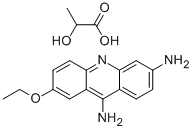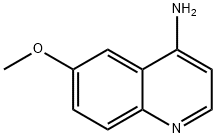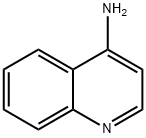6,9-DIAMINO-2-ETHOXYACRIDINE LACTATE
- CAS NO.:1837-57-6
- Empirical Formula: C18H21N3O4
- Molecular Weight: 343.38
- MDL number: MFCD00013149
- EINECS: 217-408-1
- SAFETY DATA SHEET (SDS)
- Update Date: 2025-02-21 21:32:25

What is 6,9-DIAMINO-2-ETHOXYACRIDINE LACTATE?
Chemical properties
Pale-yellow crystals. Slowly soluble in 15 parts water; soluble in 9 parts boiling water; soluble in 110 parts alcohol (22C). Solutions are yellow, fluorescent, and stable to boiling.
Originator
Rivanol,Sopharma
The Uses of 6,9-DIAMINO-2-ETHOXYACRIDINE LACTATE
Bactericide, surgical antisepsis, preparation of pure γ-globulin.
The Uses of 6,9-DIAMINO-2-ETHOXYACRIDINE LACTATE
2-Ethoxy-6,9-diaminoacridine Lactate is used in treating purulent-necrotic wounds of hooves in cattle.
Definition
ChEBI: Acrinol is an organic molecular entity.
Manufacturing Process
A mixture of 250 parts by volume of ethylene glycol, 50 parts by weight of 6-
nitro-9-chloro-2-ethoxyacridine (obtained by reaction of 52 parts by weight of
30 nitro-4-ethoxy-diphenylamine-6-carboxylic acid with phosphorous
oxychloride), 10 parts by weight of ammonium chloride, and 11 parts by
weight of urea were heated to 170°C and stirred for 1 hour at 170°-175°C.
Subsequently, the whole was cooled to 100°C, the reaction mixture was
introduced into 1000 parts by volume of water, rendered acidic to Congo
paper by means of hydrochloric acid and the 6-nitro-9-amino-2-ethoxyacridine
precipitated was filtered off. By reduction iron according to Bechamp, 6,9-
diamino-2-ethoxy-acridine hydrochloride was obtained with yield of 83% as
the yellow needles. The base was prepared by adding an equivalent of NaOH.
MP: 124°C.
In practice it is usually used as lactate.
Therapeutic Function
Antiseptic, Antibacterial
Safety Profile
Poison by subcutaneous, intraperitoneal, and intravenous routes. Experimental reproductive effects. An antiseptic. When heated to decomposition it emits toxic fumes of NOx.
Properties of 6,9-DIAMINO-2-ETHOXYACRIDINE LACTATE
| Melting point: | 235°C |
| Boiling point: | 478.66°C (rough estimate) |
| Density | 1.2764 (rough estimate) |
| refractive index | 1.5855 (estimate) |
| storage temp. | under inert gas (nitrogen or Argon) at 2–8 °C |
| solubility | DMSO:84.5(Max Conc. mg/mL);246.08(Max Conc. mM) Water:69.0(Max Conc. mg/mL);104.84(Max Conc. mM) |
| form | Solid |
| color | Pale Yellow to Light Yellow |
| CAS DataBase Reference | 1837-57-6(CAS DataBase Reference) |
| EPA Substance Registry System | Rivanol (1837-57-6) |
Safety information for 6,9-DIAMINO-2-ETHOXYACRIDINE LACTATE
Computed Descriptors for 6,9-DIAMINO-2-ETHOXYACRIDINE LACTATE
New Products
(R)-1-Boc-3-hydroxypyrrolidine Methyl (R)-1-Boc-4,4-difluoropyrrolidine-2-carboxylate 2,2-Difluoropropylamine hydrochloride tert-butyl 3-bromoazetidine-1-carboxylate DIFLUOROACETIC ANHYDRIDE 2,2-Difluoropropionic acid Diallylamine, 99% Calcium hydroxide, 95% Aluminum oxide, basic 2-Bromophenylacetonitrile, 97% L-tert-Leucine,97% N-Hydroxy-2-methylpropanimidamide 4-(3,4-Dichlorophenyl)-3,4-Dihydro-N-Methyl-1-(2H)-Naphthalenimine (Schiff Base) 2-AMINO-3,5-DIBROMO BENZALDEHYDE [ADBA] L-Glutamic Acid Dimethyl Ester Hcl 10-Methoxy-5H-dibenz[b,f]azepine 5-Cyanophthalide N, N-Carbonyldiimidazole (CDI) Dibenzoyl Peroxide Titanium Dioxide 2-(Methylthio) Benzonitrile Sodium Acetate Anhydrous Allopurinol 1,5-DibromopentaneRelated products of tetrahydrofuran








You may like
-
 Ethacridine lactate 99% (HPLC) CAS 1837-57-6View Details
Ethacridine lactate 99% (HPLC) CAS 1837-57-6View Details
1837-57-6 -
![Cis-2-(Bromomethyl)-2-(2,4-Dichlorophenyl)-1,3-Dioxolane-4-Ylmethyl Benzoate [CBB] 61397-56-6 99%](https://img.chemicalbook.in//Content/image/CP5.jpg) Cis-2-(Bromomethyl)-2-(2,4-Dichlorophenyl)-1,3-Dioxolane-4-Ylmethyl Benzoate [CBB] 61397-56-6 99%View Details
Cis-2-(Bromomethyl)-2-(2,4-Dichlorophenyl)-1,3-Dioxolane-4-Ylmethyl Benzoate [CBB] 61397-56-6 99%View Details
61397-56-6 -
 287930-77-2 / 142569-70-8 99%View Details
287930-77-2 / 142569-70-8 99%View Details
287930-77-2 / 142569-70-8 -
 Ethyl-2-Chloroacetoacetate 609-15-4View Details
Ethyl-2-Chloroacetoacetate 609-15-4View Details
609-15-4 -
 CIS- BROMO BENZOATEView Details
CIS- BROMO BENZOATEView Details
61397-56-6 -
 609-15-4View Details
609-15-4View Details
609-15-4 -
![1-(6-Methylpyridin-3-Yl)-2-[4-(Methylsulfonyl)Phenyl]Ethanone [Ketosulfone] 99%](https://img.chemicalbook.in//Content/image/CP5.jpg) 1-(6-Methylpyridin-3-Yl)-2-[4-(Methylsulfonyl)Phenyl]Ethanone [Ketosulfone] 99%View Details
1-(6-Methylpyridin-3-Yl)-2-[4-(Methylsulfonyl)Phenyl]Ethanone [Ketosulfone] 99%View Details
221615-75-4 -
 27143-07-3View Details
27143-07-3View Details
27143-07-3
